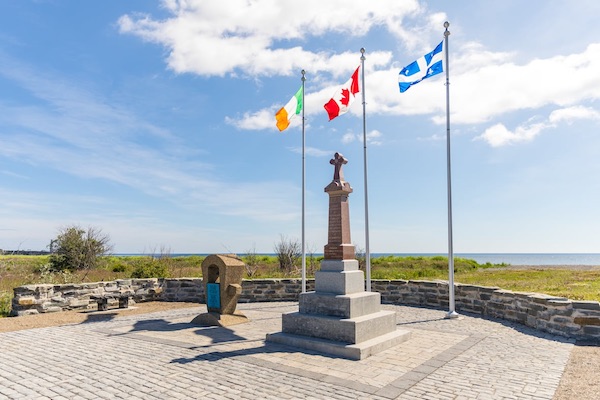
A storm has exposed the bones of Irish children on a Canadian beach, recalling a holocaust of greed that devastated Ireland and changed the world. Abridged from an article for the Washington Post by Michael E. Miller.
In the spring of 2011, a powerful storm swept over the stony shores of the Gaspe Peninsula in Quebec, Canada, just as another had 164 years earlier.
After the squall ended, the damage was being documented when a surveyor spotted something sickeningly out of place among the pebbles and driftwood.
Children’s bones.
The grim discovery launched a scientific quest to identify the remains and solve an intercontinental mystery more than a century and a half in the making.
Last week, Canada’s national parks agency announced that chemical analysis of the bones and others later found nearby indicate that they belonged to Irish immigrants who had fled the country’s Great Hunger, only to drown in an 1847 shipwreck within sight of their new home.
The findings shed light on the local folklore and fragmentary scholarship surrounding the Carricks shipwreck. They also illuminate a lesser-known chapter of Irish and Canadian history. Next month, the remains will be reburied by officials from Canada and Ireland as well as descendants of the shipwreck’s survivors.
Fleeing The Great Hunger in a ‘coffin ship’
In March of 1847, nearly 200 people crammed inside a small, two-masted ship called the Carricks of Whitehaven, which was bound from Sligo, northwest Ireland, to Quebec City in Canada. Many were women or children. Some were sick with typhus, cholera or dysentery.
All of them were probably starving.
They were tenant farmers who had tilled the fields of Henry John Temple, known as Lord Palmerston, then the foreign secretary and the future prime minister of Britain, according to a forthcoming documentary called “Lost Children of the Carricks.”
In Ireland, the Great Hunger was a period of mass starvation, disease and emigration between 1845 and 1852. Palmerston was one of the most powerful men in Britain, with 20,000 acres and over 14,000 tenants, according to the film’s website. But his wealth was being affected by the potato blight that had begun to devastate Ireland two years earlier. As the crops withered and the hungry victims stopped paying rent, Palmerston evicted them and put them on sub-standard boats bound for North America.
When the Carricks pulled out of Sligo harbor, it was one of hundreds of ships bound for Quebec from Ireland in “Black ’47,” the peak of the Great Famine. Roughly a million people would flee the island during the Great Hunger, as it was also called. Another million would die of disease or starvation. Between death and emigration, a quarter of Ireland’s 8 million inhabitants would vanish over the course of just four years.
But a spot on a brig to North America was not salvation. The same diseases that had torn through famine-weakened Ireland followed the migrants onto the ship. So many died on the journey that the boats became known as “coffin ships.”
Even if migrants escaped disease, there was also a good chance that their ship would never make it to North America. Of the nearly 400 ships that sailed toward Quebec in 1847 — most of them filled with Irish — 1 in 5 never made it.
By April 28, 1847, the Carricks had been at sea for a month. But just as the ship neared the Cap-des-Rosiers — named after the wild rosebushes that covered its green hills and white-faced cliffs — a storm struck.
“The vessel encountered a strong gale … and was driven, about two o’clock the next morning, on a dangerous shoal about sixty miles east of [Cap-des-Rosiers] and went to pieces in the course of two hours,” according to the British magazine John Bull.
Of the nearly 200 people onboard, only 48 survived, according to “Lost Children of the Carricks.” One of them, a 12-year-old girl, recalled the carnage years later as an old woman.
“After a rough and uncomfortable passage of twenty-three days, the captain missed his reckoning in a blinding snowstorm, and in the darkness of the night, struck the cruel cape,” Margaret Grant MacWhirter wrote in her 1919 history of the region, “Treasure Trove in Gaspé and the Baie des Chaleurs.”
“One stroke of the angry wave swept her clean,” MacWhirter wrote of the woman, whom she interviewed. “Comparatively few were saved, after hours of cold, hunger and fear such as may be imagined. The inhabitants came to the rescue, and treated the pitiable survivors with kindness. Truly the beach presented a gruesome spectacle the following day, strewn for a mile and a half with dead bodies. For a whole day two oxcarts carried the dead to deep trenches near the scene of the disaster.”
More than half the dead were never found. Little else was written about the shipwreck. But some of the survivors settled in the area, and the story of the bodies on the beach passed into local lore.
In 1900, St. Patrick’s Parish in Montreal erected a monument to the victims near what was thought to be the site of the unmarked mass grave. The monument was later joined by the ship’s bell, which washed up on a beach 360 miles away from the wreck in 1966.
It would not be the last reminder of the shipwreck’s terrible toll.
Scientists have determined that some of the newly uncovered bones were of children who were siblings. They also saw signs of iron deficiencies and a diet of peasants who had survived on little other than potatoes.
“These individuals had a diet low in protein,” Ribot said. “They had a famine in Ireland, food shortages, that might reflect this.”
The 21 sets of remains will be interred at the Carricks memorial in early July.
![[Irish Republican News]](https://republican-news.org/graphics/title_gifs/rn.gif)
![[Irish Republican News]](https://republican-news.org/graphics/title_gifs/harp.gif)

